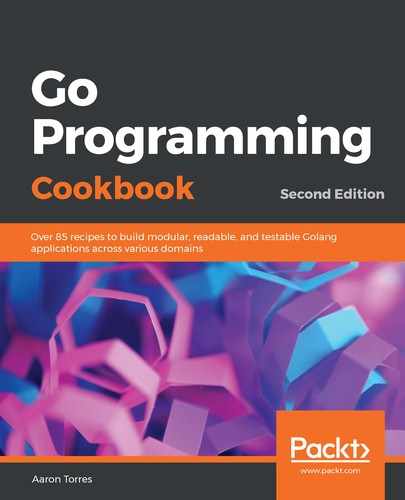The following steps cover how to write and run your application:
- From your Terminal/console application, create a new directory called ~/projects/go-programming-cookbook/chapter3/math.
- Navigate to this directory.
- Run the following command:
$ go mod init github.com/PacktPublishing/Go-Programming-Cookbook-Second-Edition/chapter3/math
You should see a file called go.mod that contains the following:
module github.com/PacktPublishing/Go-Programming-Cookbook-Second-Edition/chapter3/math
- Copy tests from ~/projects/go-programming-cookbook-original/chapter3/math or use this as an exercise to write some of your own code!
- Create a file called fib.go with the following content:
package math
import "math/big"
// global to memoize fib
var memoize map[int]*big.Int
func init() {
// initialize the map
memoize = make(map[int]*big.Int)
}
// Fib prints the nth digit of the fibonacci sequence
// it will return 1 for anything < 0 as well...
// it's calculated recursively and use big.Int since
// int64 will quickly overflow
func Fib(n int) *big.Int {
if n < 0 {
return big.NewInt(1)
}
// base case
if n < 2 {
memoize[n] = big.NewInt(1)
}
// check if we stored it before
// if so return with no calculation
if val, ok := memoize[n]; ok {
return val
}
// initialize map then add previous 2 fib values
memoize[n] = big.NewInt(0)
memoize[n].Add(memoize[n], Fib(n-1))
memoize[n].Add(memoize[n], Fib(n-2))
// return result
return memoize[n]
}
- Create a file called math.go with the following content:
package math
import (
"fmt"
"math"
)
// Examples demonstrates some of the functions
// in the math package
func Examples() {
//sqrt Examples
i := 25
// i is an int, so convert
result := math.Sqrt(float64(i))
// sqrt of 25 == 5
fmt.Println(result)
// ceil rounds up
result = math.Ceil(9.5)
fmt.Println(result)
// floor rounds down
result = math.Floor(9.5)
fmt.Println(result)
// math also stores some consts:
fmt.Println("Pi:", math.Pi, "E:", math.E)
}
- Create a new directory named example and navigate to it.
- Create a file named main.go with the following content:
package main
import (
"fmt"
"github.com/PacktPublishing/
Go-Programming-Cookbook-Second-Edition/
chapter3/math"
)
func main() {
math.Examples()
for i := 0; i < 10; i++ {
fmt.Printf("%v ", math.Fib(i))
}
fmt.Println()
}
- Run go run main.go. You could also run the following:
$ go build
$ ./example
You should see the following output:
$ go run main.go
5
10
9
Pi: 3.141592653589793 E: 2.718281828459045
1 1 2 3 5 8 13 21 34 55
- If you copied or wrote your own tests, go up one directory and run go test. Ensure that all tests pass.
